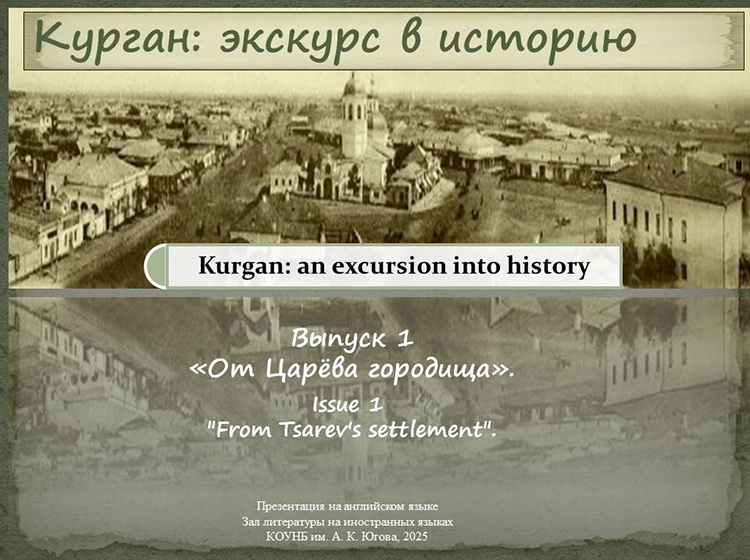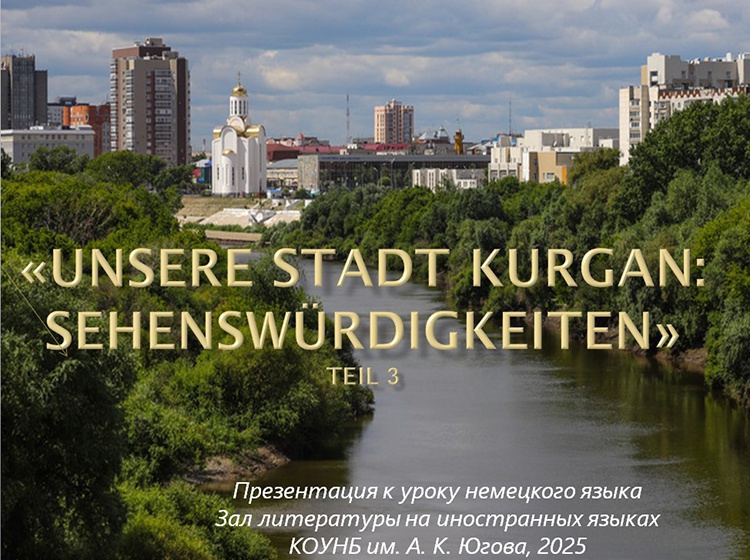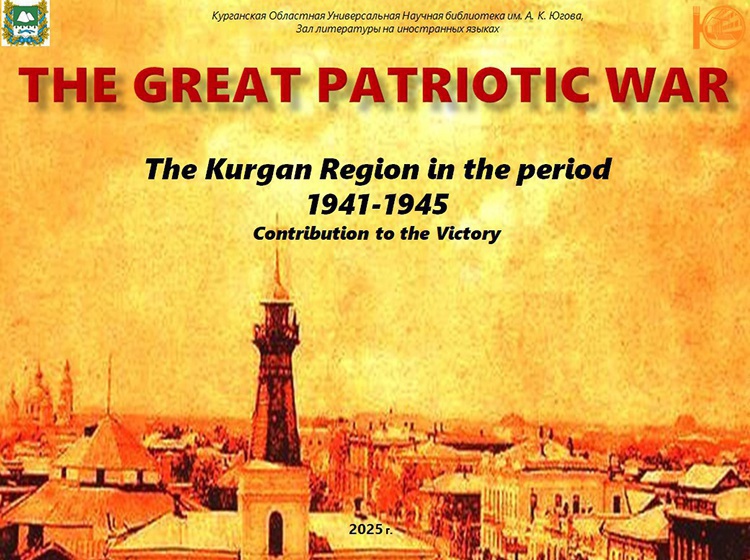«От Царёва городища» Юговка предлагает совершить виртуальный экскурс в историю родного края и поговорить на английском языке

«Kurgan: an excursion into the history. Issue 1. From Tsarev's settlement»
Презентацию можно скачать по ссылке.
In accordance with the decision of the Kurgan City Duma in September, 2009 the date of foundation of Kurgan city was considered the year 1679. This date was proposed by Doctor of Historical Sciences, Professor of the Kurgan State University V. V. Menshchikov. The first mention of the settlement of Tsarevo Gorodishche on the Tobol River dates back to the time of population census conducted by Lev Poskochin in 1680-1681. In this document, the date of foundation of the settlement is 1679. The Poskochin census is the closest official document to that period of history, and, therefore, the most accurate.
In 1679 the settlement was founded here by the peasant Timofey Nevezhin, a native of the Tyumen district. He cut down his own hut on the banks of the Tobol near the ancient mound. Soon the fortifications appeared here. The territory near the banks of the Tobol River was named Tsarevo Gorodische (meaning Imperial Citadel). It acquired an important defensive value. But the settlement had existed here since 1553.
The name Tsarevo Gorodishche is taken from a Tsarev Kurgan (large kurgan - burial mound) close to the original settlement. Its first detailed description was left by the famous scientist-encyclopedist and traveler-naturalist Pyotr Simon Pallas, who visited the Kurgan settlement in April 1771. He wrote: “This is the name of an extraordinary mound… This hill has a circumference of about 240 arshins ... To the south of this great hill there are several more small ones in direction to the river, and various grave mounds are visible ... The settlement of Tsarevo-Kurganskaya or Tsarevo settlement, in which I arrived, was six miles from those grove mounds, and its name was produced from them."
In 1782 Empress Catherine the Great signed the Decree on the formation of the Tobolsk governorate, which included the creation of the Kurgan uyezd (district). Kurgan Sloboda received the status of a city with the name Kurgan.
At the beginning of the 18th century, the settlement turned into a military fortress, which, like many other Siberian defensive points, protected the new Russian lands from the raids of the steppe nomads, including the Kazakhs. By the middle of the 18th century, the settlement had a triple fortification line and about a thousand servicemen and 28 cannons. The garrison of the fortress was the largest in the entire Tobol region. With the land-reclamation in the south and east by the Russians, the name "fortress" gradually loses its defensive meaning and eventually turns into the concept of "center" - both administrative and commercial.
At the beginning of the 19th century, the first educational institution, the first city hospital, a fire station with an observation tower were opened in the city. Residents of the city actively participated in the Patriotic War of 1812. Considering the remoteness from the center of Russia, the city was used by the authorities as a place of political exile, including for the Decembrists and participants in the Polish rebellions. Over time, the city became a center for trade in agricultural and cattle breeding products (bread, lard, meat, butter, leather). The industry was mainly represented by enterprises for the processing of agricultural raw materials. In 1856 there were 3576 inhabitants in Kurgan, two stone churches, 7 stone houses. At the end of the century there were opened: a telegraph station, the first photographic institution, an insurance company, an orphanage, a doss house, a canteen for the poor.
With the construction of the Trans-Siberian Railway (in 1892), the city began to grow rapidly. In May 1894, a telephone was set up for the needs of the city police. In 1897, there were 10 thousand 63 inhabitants in the city. In 1904, the population of the city was 19912 people. It is interesting that according to the 1910 census, 13,611 townspeople (bourgeois) lived in Kurgan, which constituted 38.1% of the total population. In terms of the number of this population group, Kurgan was in the first place in the Tobolsk province.
Before the October Revolution of 1917, Kurgan was a developed industrial and cultural city. Its population was about 40 thousand people. There were 49 enterprises with six thousand workers; there were two hospitals with 100 beds. Education was provided by the boys’ and girls’ gymnasiums, church parish and tradesman's schools, provincial and parish schools. A public library was opened, which was visited by more than a thousand people. There was also a theater, a circus, two electric theaters (cinemas), five photography establishments, two printing houses, two bookstores.
«Курган: экскурс в историю»
Выпуск 1:«От Царёва городища»
В соответствии с решением Курганской городской Думы № 255 от 16 сентября 2009 года «О дате основания города Кургана», в качестве таковой стали считать 1679 год. Обоснование этой даты было предложено доктором исторических наук, профессором Курганского государственного университета В.В. Менщиковым. Первое упоминание о слободе Царево Городище на реке Тобол относится ко времени проведения переписи Львом Поскочиным, проведенной в 1680 – 1681 годах. В этом документе датой основания поселения (в 1782 году получившего статус города Кургана) назван 1679 год. Поскочинская перепись является наиболее близким к тому периоду истории официальным документом, а, следовательно, наиболее точным.
Историю Кургана принято отсчитывать с 1679 года, с момента основания поселения слободчиком Тимофеем Невежиным, выходцем из Тюменского уезда, срубившем себе избу на берегу Тобола вблизи древнего кургана. На живописный берег реки и благодатную землю потянулись первые переселенцы.Вскоре здесь появились фортификационные сооружения. Территория у берегов реки Тобол получила название Царево Городище. Она приобрела важное оборонное значение. Но поселение на этом месте существовало с 1553 года.
Первое название — Царёво Городище — поселение получило по Царёву кургану. Название происходит от находившегося в шести верстах от слободы Кургана (могильный холм), который за свои размеры именовался Царёв Курган. Его первое подробное описание оставил известный учёный-энциклопедист и путешественник-естествоиспытатель Пётр Симон Паллас, который побывал в Курганской слободе в апреле 1771 года. Он писал: «Сим именем называется чрезвычайной величины курган… Холм сей имеет в окружности около 240 аршин… К южной стороне от великого сего холма лежит к реке еще несколько маленьких, и видны различныя могильныя насыпи… В шести верстах от оного прибыл я в слободу Царёво-Курганскую или Царёво городище, которая своё название от вышеупомянутого должна производить». В 1782 г. императрица Екатерина II подписала Указ об образовании Тобольского наместничества, в составе которого был создан Курганский уезд. Курганская слобода получила статус города с наименованием Курган.
В начале XVIII века городище превратилось в военную крепость, которая, как и многие другие сибирские оборонительные пункты, защищала новые русские земли от набегов степных кочевников, в том числе казахов. К середине XVIII века слобода имела тройную линию укрепления и насчитывала около тысячи служилых людей и 28 пушек. Гарнизон крепости был самым крупным во всем Притоболье.С освоением русскими новых земель на юге и востоке, само название «крепость» постепенно утрачивает свое оборонительное значение и со временем превращается в понятие «центр» — как административный, так и торговый.
В начале века XIX в городе были открыты: первое учебное заведение, первая городовая больница, пожарное депо со смотровой вышкой. Жители города активно участвовали в Отечественной войне 1812 года. Учитывая удалённость от центра России, город использовался властями как место политической ссылки, в том числе для декабристов и участников польских восстаний. Со временем город становится центром торговли продуктами земледелия и скотоводства (хлеб, сало, мясо, масло, кожи). Промышленность была представлена в основном предприятиями по переработке сельскохозяйственного сырья. В 1856 году в Кургане было 3576 жителей, две каменных церкви, 7 каменных домов. В конце века были открыты: телеграфная станция, первое фотографическое заведение, страховое общество, детский приют, ночлежный дом, столовая для бедных.
Со строительством Транссибирской магистрали город начал быстро расти. В мае 1894 года устроен телефон для нужд городской полиции. В 1897 году в городе насчитывалось 10 тысяч 63 жителя. В 1904 году население города составило — 19912 человек.
Интересно то, что по переписи 1910 г. в Кургане проживало 13611 мещан, что составляло 38,1% от общего числа населения. По количеству этой группы населения Курган стоял на первом месте в Тобольской губернии.
Перед Октябрьской революцией 1917 г. Курган был развитым промышленным и культурным городом. Его население составляло около 40 тысяч человек. Работало 49 предприятий с шестью тысячами рабочих; действовали две больницы на 100 коек. Образованием занимались мужская и женская гимназии, церковно-приходские и ремесленные школы, уездное и приходские училища. Была открыта публичная библиотека, которую посещали более тысячи человек. Также работали театр, цирк, два электротеатра (кинотеатра), пять фотографий, две типографии, два книжных магазина.
Вопросы к тексту
- When was the settlement of Tsarevo Gorodishche on the Tobol River mentioned for the first time?
- What is the closest official document to the period of history, connected with the foundation of Tsarevo Gorodishche settlement?
- What is the meaning of the name Tsarevo Gorodische?
- Who was the first to cut down his own hut on the banks of the Tobol near the ancient mound?
- What is the name of the famous scientist- traveler, who visited the Kurgan settlement in April 1771?
- When did Kurgan receive the status of the city?
- Why was Kurgan used by the authorities as a place of political exile?
- When did the city start to grow rapidly?
- Was Kurgan a developed industrial and cultural city before the October Revolution of 1917?
Задание. Вставить пропущенные глаголы (became, opened, represented, named, founded, participated)
- The territory near the banks of the Tobol River was --- Tsarevo Gorodische (meaning Imperial Citadel).
- A public library was ---, which was visited by more than a thousand people.
2.In 1679 the settlement was --- here by the peasant Timofey Nevezhin, a native of the Tyumen district.
3.Residents of the city actively --- in the Patriotic War of 1812.
4. Over time, the city --- a center for trade in agricultural and cattle breeding products.
5.The industry was mainly --- by enterprises for the processing of agricultural raw materials.
Используемые источники:
История города Кургана: сайт. –URL.: https://kurgan.pro/okn/istoriya/ Культурное наследие Кургана (дата обращения : 22.08.2025).
Зауральская генеалогия Курган: история, краеведение, генеалогия : сайт. - URL.: https://www.kurgangen.ru/local-finding/the%20cultu... (Дата обращения 16.08.2025)
Онлайн-урок на немецком языке «Герои Зауралья»
28 апреля 2025
Электронный каталог КОУНБ им. А.К. Югова
Каталог книг, периодических изданий, описания статей по гуманитарным наукам, экономике, технике, экологии, описания статей о Курганской области











